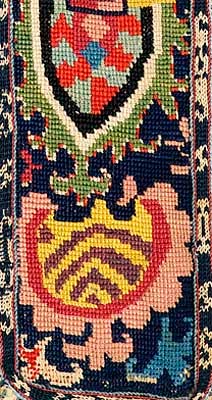Urban Embroidered Waist Bands
Central Asia, Uzbekistan
19th Century
7.6 x 91.4cm (3 x 36 in.) approx. each
Cotton, silk embroidery, cross-stitch technique
J. Alper Smith






Only recently have these embroideries come under serious examination by scholars. The visual vocabulary of these embroideries is largely floral, recalling designs originating in the high Persiate culture of the region. For example, the paisley, or boteh, design on the pouches, and the lotus palmette of the waistbands, were popular in Iran and India throughout nineteenth century. Although professional embroiderers would have produced expensive items at the time, these pouches and waistbands appear to be domestic embroideries made in the prevailing style.
Right – A Bukharan bureaucrat with small pouches hanging from his waistband. The caftan has no pockets and these pouches are used instead. Bukhara, 1905–15

